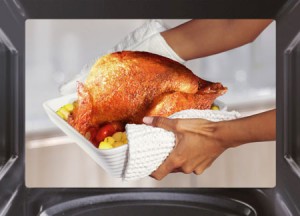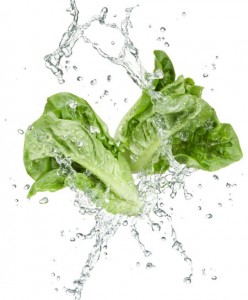By David Zinczenko with Matt Goulding
It’s not the cow’s fault.
For a ruminating herbavore, cows sure get blamed for a lot of things. They got blamed for the Great Chicago Fire. They get blamed for contributing to global warming. And now our poor cud-chewing friends are getting blamed for America’s obesity crisis, too.
Okay, it’s not the cows themselves, but their most popular end product—hamburgers—that get fingered as the perp in our ongoing weight struggles. But like I said, it’s not the cow’s fault. See, burgers used to be healthy!
Back before the fall of the Berlin Wall, the average restaurant burger weighed in at about 333 calories. But today’s typical version weighs in at almost twice that—600 calories on average. (Maybe we should have built a wall in Hamburg?)
So don’t blame the cow. Blame the food engineers in chain restaurant kitchens, who are tricking out the simple burger until it has more fleshy extras than Madonna’s stage show. In fact, burgers can be a healthy and satisfying dose of protein, if you know what to look for—and what to avoid.
In our continuing mission to create a more natural and healthier food supply, Eat This, Not That! uncovers America’s 11 most offensive burgers. Beware of them—or it won’t just be the burgers that wind up with oversized buns.
11. Worst Classic Fast-Food Burger
Burger King Whopper with Cheese
760 calories
47 g fat (16 g saturated, 1 g trans)
1,410 mg sodium
With 200 more calories than a McDonald’s Big Mac, the Whopper is the clear loser in the battle of the burger icons. Blame it on the jumbo patty and globs of mayo (160 calories worth to be exact). And get this: If you add medium fries and a medium coke—a likely scenario—you’re looking at a 1,500-calorie meal. The best way to “have it your way” at BK? Order a standard cheeseburger and call it a day, or tryCook This, Not That! Easy 350-Calorie Meals and save calories, time, and cash.
Eat This Instead!
Burger King Cheeseburger
300 calories
14 g fat (6 g saturated, 0 g trans)
710 mg sodium
10. Worst Burger Kids’ Meal
McDonald’s McDouble Mighty Kids Meal with Fat-Free Chocolate Milk Jug
765 calories
30 g fat (9.5 g saturated, 1 g trans)
1,215 mg sodium
I applaud McDonald’s for its recent move to offset fries with fruit in all its kids’ meals, but—apple slices or not—this “mighty” menu option remains the worst children’s choice at the drive-thru. The chain created the Mighty Kids Meal for “in-be-tweens” (kids aged 8 to 12). Problem is, it packs more fat and calories than an adult’s meal should. A standard Happy Meal is plenty of food for your kid—no matter their age—and chicken nuggets trump burgers any day. (Find hundreds of other tips to help your family eat better in Eat This, Not That! For Kids!)
Eat This Instead!
McDonald’s Chicken McNugget Happy Meal with 1% Low-Fat Milk Jug
405 calories
19.5 g fat (4 g saturated)
555 mg sodium
9. Worst Basic Burger
Five Guys Bacon Cheeseburger
920 calories
62 g fat (29.5 g saturated)
1,310 mg sodium
This burger bomb landed on the list for one reason: false advertising. At Five Guys, regular burgers are doubles and “Little” burgers are singles. And the burgers aren’t the only serving size rip-off the chain serves up. The “regular” fries have 620 calories—double that of most standard fry orders. The takeaway: Go “Little” or go elsewhere.
Eat This Instead!
Five Guys Little Bacon Burger
560 calories
33 g fat (14.5 g saturated)
640 mg sodium
8. Worst “Healthy” Burger
Ruby Tuesday Avocado Turkey Burger
968 calories
61 g fat
1,601 mg sodium
It’s entirely common for restaurants to top their turkey burgers with so many greasy calories that they completely nullify the small savings you get by choosing turkey over beef. Ruby Tuesday’s Avocado Turkey Burger, for example, has more calories than the chain’s Classic Cheeseburger. The lesson: Turkey doesn’t always mean healthier.
Eat This Instead!
Asiago Peppercorn Sirloin
401 calories
20 g fat
1,023 mg sodium
7. Worst Burger Melt
Red Robin All-American Patty Melt
1,254 calories
94 g fat
1,951 mg sodium
Melts are notoriously high in calories, thanks to copious amounts of butter and cheese, and Red Robin takes the diner classic from poor to preposterous by adding 350 calories of Thousand Island dressing. This “All-American” monstrosity is the highest-calorie burger on the menu, but unfortunately, the others are close behind. In fact, the Keep it Simple Burger is the chain’s only burger that falls below 800 calories, which makes it your only sane option.
Eat This Instead!
Red Robin Keep It Simple Burger
569 calories
24 g fat
991 mg sodium
6. Worst BBQ Burger
Chili’s Shiner Bock BBQ Burger
1,300 calories
74 g fat (24 g saturated)
2,840 mg sodium
An average burger at Chili’s packs 1,400 calories, and the Shiner Bock is among the worst of the lot. The burger’s main calorie culprit: crispy onion strings. Last time I checked, deep-fried onions were a side dish—and a shoddy one at that. This dish also comes standard with 380 calories of fries, so all said, you’re looking at nearly a day’s calories in one sitting. If you want to get your red-meat fix at Chili’s, steak’s the only way to go.
Eat This, Instead!
Chili’s Custom Combinations Classic Sirloin with Sweet Corn on the Cob and Steamed Broccoli
520 calories
21 g fat (7 g saturated)
1,770 mg sodium
5. Worst Sliders
Applebee’s Cheeseburger Sliders with Applewood Smoked Bacon
1,340 calories
87 g fat (75 g saturated, 3 g trans)
2,550 mg sodium
Sliders are particularly sneaky diet traps. First, despite their diminutive stature, they tend to pack as many—if not more—calories as their full-size brethren. Second, they’re often listed as appetizers, which means you risk wolfing down more than a meal’s worth of calories before you even set eyes on your entrée. My advice: Go with a leaner appetizer like the Grilled Chicken Wonton Tacos—the only Applebee’s option under 600 calories—and consider sharing with a friend.
Eat This Instead!
Applebee’s Grilled Chicken Wonton Tacos
590 calories
24 g fat (4.5 g saturated, 0 g trans)
2,150 mg sodium
4. Worst Double Cheeseburger
Denny’s Double Cheeseburger
1,400 calories
87 g fat (41 g saturated, 2 g trans)
2,680 mg sodium
Some things are better in pairs: skis, wings, Super Bowl tickets. But burgers? Not so much. An extra patty adds little flavor and costs you big on the bathroom scale. Take this double whammy from Denny’s: double patties, double cheese, double a day’s saturated fat, and 2 grams of trans fat. What do all these twos add up to? Double chins. The 540-calorie Veggie Burger is the chain’s only safe burger option, but if you’re an unabashed carnivore, you’ll appreciate the Prime Rib Skillet.
Eat This Instead!
Denny’s Prime Rib Skillet
585 calories
38 g fat (12.5 g saturated)
1,460 mg sodium
3. Worst Crazy Burger Creation
Friendly’s Grilled Cheese Burger
1,540 calories
92 g fat (35 g saturated)
2,490 mg sodium
American chains are constantly dreaming up wacky dishes designed to get your novelty neurons firing at the speed of light. Perhaps the single best example of this frankenfood effect: the Grilled Cheese Burger from Friendly’s. It’s a giant burger wedged between two grilled cheese sandwiches. Need I say more? If you’re craving grilled cheese, order grilled cheese.
Eat This, Instead!
Friendly’s Grilled Cheese Sandwich
800 calories
37 g fat (14 g saturated)
1,280 mg sodium
2. Worst Fast-Food Burger
Sonic Ring Leader Loaded Burger Double Patty
1,660 calories
120 g fat (44 g saturated, 4 g trans)
1,450 mg sodium
The recent unveiling of this menacing half-pound burger marks a new low for a chain that already suffers from an iffy reputation. The bacon strips and onion rings will receive much of the criticism, but it’s the less flashy components that hold the hidden danger. In fact, the two slices of cheddar cheese and the double slather of mayo account for a third of the fat. (Then there’s the “bun oil” Sonic squeezes on.) If you need a burger fix, there are less perilous ways to get it.
Eat This Instead!
Jr. Deluxe Burger with Bacon and Green Chilies
425 calories
25 g fat (8 g saturated, 0.5 g trans)
705 mg sodium
1. Worst Burger in America
Chili’s Jalapeño Smokehouse Bacon Burger
1,910 calories
126 g fat (43 g saturated)
5,290 mg sodium
This tricked-out number is the worst of the worst of Chili’s’ burger behemoths. It comes saddled with tortilla strips, bacon, cheddar, mayo, and jalapeno-ranch dressing, the combined impact of which is more than 2 days’ worth of saturated fat and as much sodium as you’d find in 6 pounds of McDonald’s French fries.
Eat This, Instead!
Chili’s Margarita Grilled Chicken
550 calories
14 g fat (4 g saturated)
1,870 mg sodium
Original Article: http://health.yahoo.net/experts/eatthis/11-worst-burgers-america


















